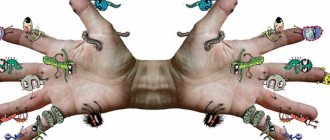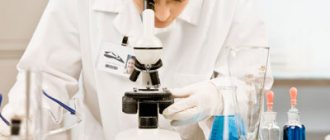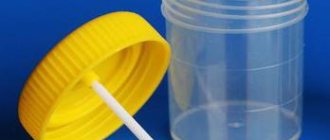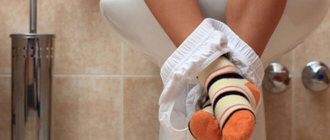The article was prepared by a specialist for informational purposes only. We urge you not to self-medicate. When the first symptoms appear, consult a doctor.
If helminthiasis is suspected or as part of a preventive medical examination, a stool test is performed for worm eggs. This laboratory diagnostic procedure has become widespread and is prescribed to both children and adults.
What is a stool test for worm eggs?
During this manipulation, the laboratory assistant examines the feces for the presence of helminth eggs. As a result of this analysis, eggs of almost all parasites known to medicine can be identified, and this is about 250 species. In the human body they reproduce by laying eggs. Most varieties of helminths parasitize the human intestine or other parts of the gastrointestinal tract. In this case, the eggs of worms enter the digestive tract, and from there they are excreted along with feces.
A smear containing feces from the patient being examined is examined under a microscope. Multiple magnification allows you to see eggs and larvae of helminths in the diagnostic material.
This sign allows us to say for sure that the body is parasitized by worms of one of three groups:
- Nematodes (roundworms, whipworm, necator);
- Fluke flukes (schistosoma, liver fluke, cat fluke, or lanceolate fluke);
- Cestodes (tape tape, small and wide tapeworm).
In addition to helminth eggs, their shells, as well as dysenteric amoebas, Giardia and cyclosporidium oocysts, can be found in feces.
How long does it take to prepare the analysis and how is it carried out in the laboratory?
If possible, the stool sample is immediately processed or placed under appropriate temperature conditions before testing begins. In some cases, a preservative may be used. Sample preparation and specifics of the study depend on the method used.
- Macroscopic methods are used to detect mature helminths or their fragments using a magnifying glass or stereoscope. Using tweezers, remove all suspicious formations from the surface of the stool onto a Petri dish, examine them through a magnifying glass and under a microscope between slides.
- Thick smear method. A thin layer of feces sample is examined on a glass slide under a special hygroscopic cellophane, which is impregnated with phenol, glycerin and malachite green. A pea-sized stool sample is applied to the glass, rubbed with a glass rod and covered with a cellophane strip, cleared for half an hour. With such preparation, you can view 30 times more drugs.
- Sedimentation (precipitation) method. It is based on the difference in the specific gravity of the reagents and helminth eggs, which are concentrated in the sediment. The sediment is obtained using a centrifuge and further examined under a microscope. Modified sedimentation methods with the “Real” mini-system and disposable cones are also used.
- Method for studying feces using flotation solutions. The technique is based on the difference in the specific gravity of helminth eggs and the flotation solution - helminth eggs float and concentrate in the surface film. Next, the film is examined under a microscope.
Indications for examining stool for worm eggs
As a screening for a large number of adults and children, stool analysis is carried out when filling out a health record, upon admission to school, kindergarten and any group where there is a risk of transmission of helminthiasis. This kind of barrier blocks the spread of parasites.
Another reason for testing is suspicion of helminthiasis. Since worms carry out their vital functions in various organs, the symptoms of parasitic infestation may be similar to the manifestations of pathologies of the liver, intestines, brain, bladder, urethra, and lymph nodes. To differentiate helminthiasis from other diseases, a stool test is performed for worm eggs.
Symptoms of helminthiasis:
- Itching in the anal area;
- Pain in the intestines;
- Alternating diarrhea and constipation, bloating;
- Increased fatigue and irritability;
- Sleep disorders;
- Vulvovaginitis in women;
- Allergy symptoms due to toxic damage to the body by helminth waste;
- Increased concentration of eosinophils in the blood;
- Night bruxism (teeth grinding);
- Infections of the genitourinary system.
In children, the following manifestations of helminthiasis are added to the listed symptoms:
- Urge to defecate without ending;
- Restless sleep, night crying, whims;
- Irritation of the anal area;
- Cough of unknown etiology.
If one or more alarming symptoms appear, the therapist or pediatrician suspects helminthiasis. In complex cases, stool analysis for worm eggs is supplemented with studies of sputum, bile, gastric juice, and blood. It is advisable to conduct such a study every six months for children attending children's groups, and annually for adults working with young children.
Indications for diagnostics
It is recommended to take the test at least once a year. The most relevant research is for people who have an increased risk of contracting helminthiasis:
- constant stay in a closed community (preschool and school institutions, boarding schools, barracks, etc.);
- insufficient compliance with hygiene rules or the impossibility of observing them (field work);
- consumption of river fish and meat that have undergone insufficient heat treatment;
- constant contact with agricultural domestic animals (owners of personal farmsteads, rural residents);
- breeding dogs and working with them.
Stool analysis is included in the list of standard tests when obtaining a medical certificate for visiting kindergartens, schools and other institutions, and is also prescribed during medical examinations:
- for hiring;
- as part of periodic medical examinations of specialists working in the fields of healthcare, education, catering and trade and some others.
It is recommended to get tested if signs of helminthiasis appear:
- weight loss for no apparent reason;
- constant weakness, shortness of breath;
- reduced performance;
- poor sleep;
- pain in joints and muscles;
- heaviness in the right hypochondrium;
- nausea;
- a feeling of bitterness in the mouth;
- periodic abdominal pain, especially in the navel area;
- stool disorders - diarrhea or constipation;
- pallor of the skin and mucous membranes;
- allergic phenomena: dermatitis, skin itching, acne;
- itching in the anal area.
How to prepare for a stool test for worm eggs
To achieve objectivity of the study, at least 3 stool samples must be performed. This tactic is due to the peculiarities of the vital activity of helminths, the next generation of which can appear from eggs after receiving a negative result.
Restrictions before taking the analysis:
- Do not take mineral or castor oil (for a week);
- Do not use antibiotics, medicines against diarrhea and parasites, magnesium and bismuth preparations;
- Irrigoscopy is not recommended;
- The consumption of vegetables and fruits that provoke flatulence and diarrhea (cabbage, pears, cucumbers, beets, oranges) is limited;
- You should not drink compotes and jelly made from brightly colored berries that change the color of feces; you should not eat them fresh (cherries, raspberries, blackberries, etc.);
- You must not use drugs or alcohol.
To collect the analysis, disposable containers purchased from the pharmacy chain are used. In this case, the risk of eggs or larvae from outside joining the research material is eliminated.
Collection of feces for worm eggs
The most informative is the collection of stool during morning bowel movements, although evening analysis can show objective results. A fecal sample is collected into a pharmaceutical container using a special device included with it. If stool is collected in another suitable container, use any clean sticks. It is advisable that different samples get into the container, both from the edge and from the inside of the fecal mass.
The container is sealed and sent to the laboratory, having previously signed it. It is better that the study is carried out 40-60 minutes, maximum 5-7 hours after defecation. The stool sample should be stored in a cool place at a temperature not exceeding +4+8°C. If the material for analysis has been at room temperature for more than an hour, it is considered unsuitable for research.
Perianal prints
Eggs of pinworms and tapeworms that parasitize the intestines can be detected by microscopy of prints from the skin near the anus.
Before the analysis, it is impossible to toilet the anal area, and it is also unacceptable to conduct the study after defecation. Optimally - in the morning immediately after waking up. To take an analysis, adhesive tape is used, which is pressed against the anus with the adhesive side for 1-2 seconds and then evenly glued onto a glass slide. The edges of the film protruding along the edges of the glass are cut off.
Most often, the study is carried out on children, and the prints are taken by the parents - the glass and tape are given by a nurse at a clinic or kindergarten. It is allowed to store scrapings for enterobiasis for no more than 8 hours, ensuring a storage temperature of no more than 4 degrees (in the refrigerator). Examined under a microscope.
Methodology for analyzing stool for worm eggs
In modern helminthology the following methods of coproovoscopy are used:
- Microscopy of a native smear - examination at significant magnification of a preparation prepared from water and feces. A piece of feces soaked in distilled water is placed on a glass slide greased with glycerin. It is mixed with glycerol, covered with a coverslip and analyzed using a microscope;
- Fullenborn's test is a study under a microscope of a film formed on the surface of a solution of feces with salt water. If there are eggs in the feces, they float within an hour and a half;
- Thalmann's test is a study under a microscope of a centrifuged suspension of feces, ether and hydrochloric acid.
Worm eggs found in one of the samples give grounds to determine the result of the study as positive. The absence of traces of helminths is positioned as a negative result. The duration of the study is 1-3 days, depending on the equipment and workload of the laboratory.
The results should be shown to the doctor who referred the patient for diagnosis. Analysis of stool for worm eggs can be carried out in a bacteriological laboratory at a sanitary and epidemiological station or in a private clinic licensed to conduct such research.
Sources
- Lagatie O., Verheyen A., Van Hoof K., Lauwers D., Odiere MR., Vlaminck J., Levecke B., Stuyver LJ. Detection of Ascaris lumbricoides infection by ABA-1 coproantigen ELISA. // PLoS Negl Trop Dis - 2022 - Vol14 - N10 - p.e0008807; PMID:33057357
- Stehr M., Grashorn M., Dannenberger D., Tuchscherer A., Gauly M., Metges CC., Daş G. Resistance and tolerance to mixed nematode infections in relation to performance level in laying hens. // Vet Parasitol - 2022 - Vol275 - NNULL - p.108925; PMID:31605937
- Daş G., Westermark PO., Gauly M. Diurnal variation in egg excretion by Heterakis gallinarum. // Parasitology - 2022 - Vol146 - N2 - p.206-212; PMID:29978775
- Xu BL., Zhang HW., Deng Y., Chen ZL., Chen WQ., Lu DL., Zhang YL., Zhao YL., Lin XM., Huang Q., Yang CY., Liu Y., Zhou RM ., Li P., Chen JS., He LJ., Qian D. . // Zhonghua Liu Xing Bing Xue Za Zhi - 2022 - Vol39 - N3 - p.322-328; PMID:29609247
- Dever ML., Kahn LP., Doyle EK., Walkden-Brown SW. Immune-mediated responses account for the majority of production loss for grazing meat-breed lambs during Trichostrongylus colubriformis infection. // Vet Parasitol - 2016 - Vol216 - NNULL - p.23-32; PMID:26801591
- Silveira AM., Costa EG., Ray D., Suzuki BM., Hsieh MH., Fraga LA., Caffrey CR. Evaluation of the CCA Immuno-Chromatographic Test to Diagnose Schistosoma mansoni in Minas Gerais State, Brazil. // PLoS Negl Trop Dis - 2016 - Vol10 - N1 - p.e0004357; PMID:26752073
- Corstjens PL., Nyakundi RK., de Dood CJ., Kariuki TM., Ochola EA., Karanja DM., Mwinzi PN., van Dam GJ. Improved sensitivity of the urine CAA lateral-flow assay for diagnosing active Schistosoma infections by using larger sample volumes. // Parasit Vectors - 2015 - Vol8 - NNULL - p.241; PMID:25896512
- Nielsen MK., Wang J., Davis R., Bellaw JL., Lyons ET., Lear TL., Goday C. Parascaris univalens—a victim of large-scale misidentification? // Parasitol Res - 2014 - Vol113 - N12 - p.4485-90; PMID:25231078
- Leles D., Cascardo P., Freire Ados S., Maldonado A., Sianto L., Araújo A. Insights about echinostomiasis by paleomolecular diagnosis. // Parasitol Int - 2014 - Vol63 - N4 - p.646-9; PMID:24780138
- Negrão-Corrêa D., Fittipaldi JF., Lambertucci JR., Teixeira MM., Antunes CM., Carneiro M. Association of Schistosoma mansoni-specific IgG and IgE antibody production and clinical schistosomiasis status in a rural area of Minas Gerais, Brazil. // PLoS One - 2014 - Vol9 - N2 - p.e88042; PMID:24505371








